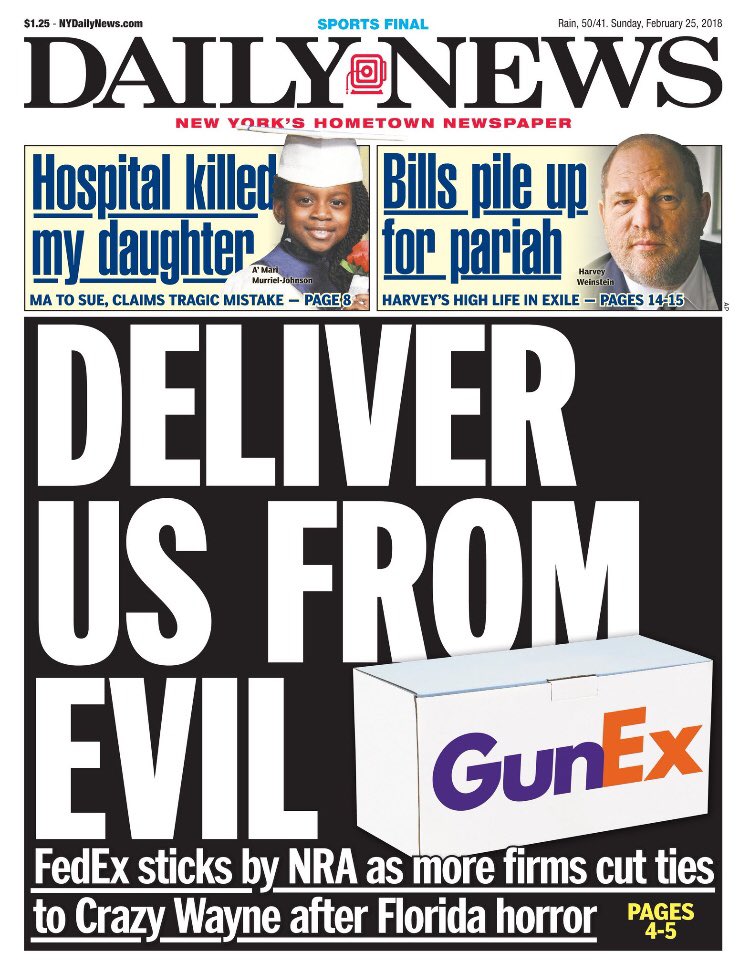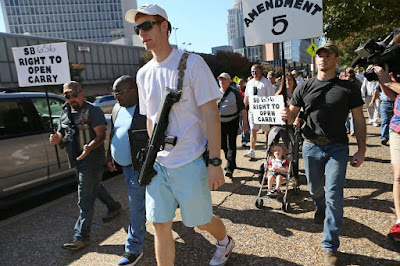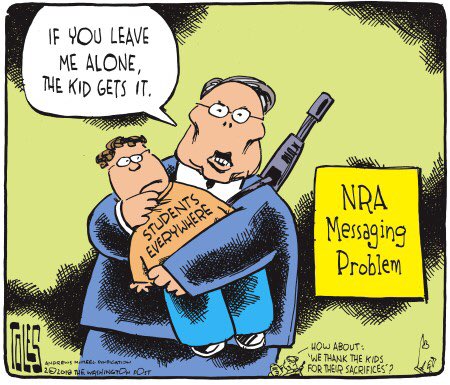2/21/2018
Let's Call Extremist Gun Owners What They Are: Sick and in Need of Help
One of the things I learned firsthand over the last few days of gun “rights” proponents attacking me for advocating a ban on certain weapons is genuinely distressing. It’s not that a lot of people own a lot of guns, although that’s disturbing enough. No, it’s that I believe, sincerely and with no malice, there is a widespread mass hysteria, if not outright mental illness, connected to a certain paranoid strain of gun owner.
Before someone says something like “Crazy liberal says every gun owner is crazy,” let me state as clearly as possible: I’m not saying every gun owner is crazy. If I meant that, I’d say it. You can be a gun owner and be perfectly sane. For instance, a good many gun owners believe the NRA is full of shit. A good many gun owners support things like a ban on semi-automatic rifles and handguns because, let’s face it, the chance of you being in a situation where you need to be able to keep shooting is pretty goddamn small.
But then there are gun owners who believe they need to stockpile weapons because they might need to go to war with the American government if it becomes a "tyranny" (which seems to mean "not as white and male"). Those people have gone mad with paranoia. And I'm not talking your typical kind of Fox "news" paranoia. I'm talking Alex Jones-levels of hysteria.
How so? By all accounts, we are living through an extended period of record low crime throughout much of the country. There is virtually no chance a foreign invader could send an army here to take over even part of the United States. And, despite all the hype, the number of terrorist incidents post-9/11 have been as small in number and number of deaths as terrorism pre-9/11. Indeed, the people who stockpile guns to await an Armageddon (Islamic or Christian or Communist or whatever) are more likely to commit acts of terrorism than any foreigner here. But, like crime rates, the number of terrorist incidents was higher in the 1970s than now.
These are facts. They are not opinions. They are borne out by study and statistics and history. Yet, in defiance of those facts, gun hoarders believe that it’s inevitable that they will need to defend the Constitution (well, the 2nd Amendment) against the United States military or some secret black-ops force or something. It's nonsensical, but it's the logic of the paranoid.
If you are given facts yet you refuse to acknowledge those facts are real, that’s delusional. If a horse is standing in front of me and people tell me that a horse is standing right in front of me, what would those people say if, knowing I had perfectly fine eyesight, I simply denied the existence of the horse. They’d wonder what the hell was wrong with me, as well they should. And no one should let me have a goddamn horse.
The good Russ Belville asked an interesting question over on the Rude Pundit Patreon page. He wondered if the gun hoarders who keep saying that we need to take care of the mentally ill would be willing for police to confiscate the guns of someone who is deemed legally insane or a potential danger to themselves or others. It’s a simple question that’s a put-up or shut-up kind of thing.
But maybe I'm being too harsh. In his New York Times "column" (if by "column," you mean "a desperate stroll through a barren wasteland and pretending that it's still a verdant meadow") yesterday, David Brooks argues that the left needs to respect the rights of gun owners more, even the most extremist ones. They see the desire to have a few more regulations, like background checks, maybe even a license and insurance, but most especially banning of any currently legal firearms as an attack on their “culture.” That ain’t a good enough excuse.
Motherfucker, cultures change all the time. Polygamy used to be part of Mormon culture. Then it turned out that polygamy was being used as an excuse to assault children. So it was outlawed in the place where it had been a big-ass part of the culture. People adapted and changed. And a whole lot of girls didn’t get raped by grown men. (Am I comparing 2nd Amendment absolutism to polygamy? Sure. Why not?)
Brooks talks about how the "Reds" (in this case, not the Commies, but people who believe in conservative ideology) hate being "shamed" by the "Blues" when they are brought together for a conversation: "The Reds feel shamed by the Blues to a much greater degree than the Blues realize. Reds are very reluctant to enter into a conversation with Blues, for fear of further shaming." And, truly, shame has been used to silence people. But if your perspective on school shootings is that dead children and fear in the classroom are just the price one pays for the "freedom" of mass gun ownership, well, you can kind of go fuck yourself and feel ashamed. People like Brooks who want the left to "reason" with the delusional and the factually wrong are exacerbating the damage done by the paranoiacs.
Indeed, the only response to people who think this way, who are trying to discredit the activated students of Marjory Stoneman Douglas High School in Parkland, Florida, the only thing that should be said to people who believe the lies being told about the kids who are now advocating for gun control should be that they are sick and they need help. Those liars shouldn't be given a platform. They shouldn't be put on a panel with people who are basing their arguments on facts. They should be told to listen to the kids, goddamnit. They are the Active Shooter Drill Generation. They've been dealing with this shit for their entire lives. They have a fuck of a lot more credibility than someone snarling about jackboots and chem trails.
Essentially, we have a large, sick segment of the population that is divorced from reality and heavily-armed. They are being exploited by craven politicians, the greedy gun lobby, and the conflict-hungry media, which makes them think that their delusional thinking has merit instead of being a symptom of damage done to them and to the public in general.
And, frankly, until we start treating them that way, as sick, which, may, yeah, make them feel a bit ashamed, nothing will fundamentally change, and this corrosion of our American soul around the bloody bullet holes will rot us away.
2/23/2018
Violent Things That Have More Influence on Kids Than Movies or Video Games
1. The guns you can buy at family-friendly places like Cabela's, a "sporting goods" store. This is from their 2016 Black Friday ad:
2. The President of the United States saying, "This crazy man who walked in wouldn't even know who it is that has (a gun), that’s good. It's not bad, that's good. And a teacher would've shot the hell out of him before he knew what happened." You can put in the words of any politician who glorifies gun violence. Same effect.
3. These pathetic idiots on an open-carry march.
4. The NRA's Mistress of Doom Dana Loesch telling gun owners to be ready to go to war. And the NRA in general.
5. Dumbass parents who teach their kids as young as 5 to shoot semiautomatic guns.
6. Trigger-happy cops, whose actions teach that shooting first is just what you do.
7. The worthless death penalty, which teaches that murder solves your problems.
8. Oh, yeah. And maybe all the motherfucking guns themselves. Maybe the real, physical guns that can fucking kill people have more of an influence than fantasy deaths. Or is it just easier to blame fiction than blame reality?
http://rudepundit.blogspot.com
The only thing that can stop a loud party is good guy with a gun.
https://www.sfgate.com/news/article/Pol ... um=twitter
"Since we passed our legislation in Connecticut, which was comprehensive in nature, in 2013, we've had the largest drop in violent crime of any state in the nation by a substantial amount..."
- Gov. Dan Malloy CT
Dan Rather: Covering Trump is like "facing a fertilizer spreader in a windstorm"

How The NRA Silenced the Science of Gun Violence Prevention
If, as the NRA claims, more guns lead to less crime, why are they opposed to funding studies that could back up their assertion?
Caroline O.Jun 19, 2017
Another mass shooting.
Another body count.
Another unending list of questions.
Why does this keep happening? Are we missing warning signs? Can we identify high-risk individuals ahead of time? Are there laws that could prevent or reduce firearm injuries and deaths? If so, what laws are most effective at mitigating the risks?
These are questions that are answerable through the scientific method. Indeed, we might very well know the answers to these questions, or at least have a growing body of evidence to guide us, if leading government scientists and federal agencies were given the funding to study them.
But they’re not: Thanks to a 23-word rider attached to a federal spending bill in 1996 and enacted in 1997, research on gun violence has been frozen for two decades.
The Scandalous History of The Federal Freeze on Gun Violence Research Funding
The freeze on federal funding for gun violence research can be traced back to 1993, when Dr. Arthur Kellerman and colleagues published the results of a CDC-funded study in the prestigious New England Journal of Medicine (NEJM). The study, “Gun ownership as a risk factor for homicide in the home,” found that keeping a gun in the home was strongly and independently associated with an increased risk of homicide. Rather than confer protection, the study concluded that people who keep guns in the home faced a 2.7-fold greater risk of homicide and a 4.8-fold greater risk of suicide.
The NEJM article was the subject of significant media attention, and the National Rifle Association (NRA) responded by trying to shut down the entire center that had funded the study, the CDC’s National Center for Injury Prevention. The center itself survived, but in 1996, Dickey — backed by the NRA — authored an amendment that cut $2.6 million from the CDC’s budget — the exact amount the CDC had invested in research on firearm injuries the previous year.
Passed by a Republican-dominated Congress, the NRA-backed ‘Dickey Amendment’ stated that “[n]one of the funds made available for injury prevention and control at the Centers for Disease Control and Prevention may be used to advocate or promote gun control.” While the amendment doesn’t explicitly ban research on gun violence, the deliberately vague wording — combined with an onslaught of harassment of researchers — had a chilling effect on scientific progress, effectively ending all federal research programs related to gun violence. As Dr. Mark Rosenberg, former director of the CDC’s National Center for Injury Control and Prevention, put it: “The scientific community has been terrorized by the NRA.”
The Dickey Amendment, passed in 1996, prohibited federal funding for any research that could be construed as advocating for or promoting gun control. It was accompanied by a $2.6 million cut to the CDC’s budget — the exact amount the agency had invested in research on firearm injuries the previous year. (Image Credit: U.S. Government Publishing Office)
“Precisely what was or was not permitted under the clause was unclear,” Dr. Kellerman wrote in a December 2012 article in the Journal of the American Medical Association. “But no federal employee was willing to risk his or her career or the agency’s funding to find out. Extramural support for firearm injury prevention research quickly dried up.”
It’s important to note that the freeze on funding doesn’t just impact federal agencies — it applies to federally-funded researchers everywhere. At universities and medical centers nationwide, where research is highly dependent on federal grants, published studies on gun violence dropped off dramatically after the passage of the Dickey Amendment — by about 60% between 1996 and 2010 — while federally funded gun violence research dropped by approximately 96% during the same period. Furthermore, CDC officials say the funding freeze and subsequent lapse in gun violence research caused lasting damage to the field. After funding was cut off, leading researchers moved on to other areas of study that were still supported by the government, and some researchers even discouraged students from specializing in gun violence research because of the lack of funding. Although private violence prevention agencies continued to support research on gun violence, they were unable to produce or analyze nationwide data on gun violence without the work of institutions like the CDC.
The amendment — and the message it sent to scientists — also had the effect of making gun-related research questions controversial even for studies not funded by the government, as scientists feared such research would be held against them if they applied for federal grants in the future. According to a 2017 study published in the Journal of the American Medical Association, gun violence was the least-researched cause of death in the U.S. and the second-least funded cause of death over the past decade.
“As a result of [the Dickey Amendment], many, many people stopped doing gun research, [and] the number of publications on firearm violence decreased dramatically,” Dr. Fred Rivara, a professor of Pediatrics and Epidemiology at the University of Washington at Seattle Children’s Hospital, and a co-author of the 1993 NEJM study, told PRI’s The Takeaway. “It was really chilling in terms of our ability to conduct research on this very important problem.”
Silencing The Science of Gun Violence Prevention
Over the last two decades, Republicans have exploited the Dickey Amendment to argue their case that gun violence is not a public health issue — a view that stands in stark contrast to the position of professional medical and public health organizations, at least 52 of which have independently urged lawmakers to treat gun violence as a pressing public health epidemic. Despite this overwhelming consensus from the scientific community, congressional Republicans actually expanded the scope of the Dickey Amendment to apply to the National Institutes of Health in 2011, after Dr. Douglas Wiebe, an epidemiologist at the University of Pennsylvania’s Perelman School of Medicine, authored a 2009 NIH study that confirmed a significant association between gun possession and gun assault.
In 2013, following the shooting at Sandy Hook Elementary School, President Obama called on the CDC to resume funding for research into the causes of gun violence. He also asked on Congress to give the CDC $10 million so they could carry out such research, but Congress has not allotted any of those funds in subsequent budgets. While the CDC developed a plan to use this funding on studies addressing firearm injury prevention and control, the agency’s research agenda remains frozen due to congressional inaction. Most recently, in the wake of the 2015 Charleston church shooting, the GOP-controlled Appropriations Committee of the U.S. House of Representatives rejected an amendment that would have lifted the federal funding freeze. Former House Speaker John Boehner defended the lack of government research, saying “a gun is not a disease.”
Notably, we heard the exact same argument back in the middle of the 20th century, when motor vehicle accidents were responsible for killing more than 50,000 Americans a year. The common wisdom, as told by carmakers, was that automobile fatalities were the fault of individual drivers — in other words, ‘cars don’t kill people; drivers kill people.’ This assertion was ultimately shown to be false, but we only discovered the truth after years of rigorous injury prevention and control research conducted by scientists at the CDC. Contrary to the claims of the automobile industry, vehicle design was found to be just as much to blame for high fatality rates as bad drivers. Researchers also discovered that motor vehicle deaths could be significantly reduced with simple safety devices such as air bags and seat belts, as well as road design features such as median barriers. The National Traffic and Motor Vehicle Safety Act of 1966 mandated many of these improvements. It also marked the start of a decades-long federal effort to better understand automobile and highway safety through systematic data collection and analysis. As a result of these studies — and the policies that grew out of them— the motor vehicle fatality rate per mile traveled has fallen 80 percent since 1966.
The insights that emerged from this line of research formed the foundation of the public health approach to injury prevention, an evidence-based model that incorporates 1) ongoing surveillance and monitoring of trends in injury-related morbidity and mortality; 2) identification of risk and protective factors; 3) continuous evaluation and development of prevention strategies; and 4) dissemination of the most efficacious strategies for reducing the incidence and burden of injuries. In addition to motor vehicle safety, this basic model has been applied successfully to reduce the public health burden of intentional and unintentional causes of injury, including poisonings, drownings, child and elder abuse, dating violence, and sexual violence.
The public health model of injury prevention, which was developed based on studies of motor vehicle crashes, could also be applied to reduce the public health burden of gun violence — but it’s not, thanks to a two-decade-old amendment that froze federal research on gun violence prevention. (Image Credit: U.S. Centers for Disease Control & Prevention)
We could use the same injury prevention model to study gun violence and reduce its massive public health impact. But unlike car manufacturers, the gun industry — led by the NRA — has been successful in their efforts to suppress scientific inquiry into gun violence and potential approaches to prevention. Moreover, while certain federal agencies like the ATF collect basic data on criminal uses of firearms, prohibitions on data-sharing have stymied scientific research on the subject. For example, as Jennifer Mascia explained in The Trace, the ATF is prohibited from “releasing crime-gun trace data to anyone other than a law enforcement agency or prosecutor — leaving academics and researchers without easy access to valuable data.”
The end result is that many fundamental questions about gun deaths and injuries, such as how many Americans are shot each year, remain unanswered, and we lack the data to establish basic parameters like the magnitude, scope, characteristics, and consequences of firearm violence. That’s important, as public health professionals rely on this type of data to identify risk and protective factors, as well as to develop effective violence prevention strategies. Insufficient research also makes it difficult for policymakers, even in states with strong firearm laws like Massachusetts and California, to know which laws will be effective, since there’s very little data for evaluation. This has meant in practice that “there is no scientific consensus on the best approach to limiting gun violence,” the New York Times reported in a 2011 article, “and the NRA is blocking work that might well lead to such a consensus.”
Even former Congressman Dickey — the Republican who wrote the original provision banning gun violence research — has recanted and urged Congress to repeal the ban, writing in an op-ed that, unlike researchers studying car accidents or infectious disease, “U.S. scientists cannot answer the most basic question: what works to prevent firearm injuries?”
If, as the NRA claims, more guns lead to less crime, why are they opposed to funding studies that could back up their assertion? The very thought is apparently enough to terrify the NRA, which is why they’ve gone to such extreme lengths to suppress this line of research and any policies that might grow out of it.
“If there is no research, it is harder to make suggestions for policy reform,” Dr. Garen Wintemute, director of the Violence Prevention Research Program at the University of California-Davis, told the Huffington Post. “And if you have a vested interest in stopping policy reform, what better way to do it than to choke off the research? It was brilliant and it worked. And my question is how many people died as a result?”
We didn’t have to ban automobiles to cut motor vehicle fatalities — and we don’t have to ban guns to reduce gun-related deaths. What we do need, however, is a willingness to objectively examine the causes of gun violence — and elected leaders who care enough about American lives to go where the data lead.
https://medium.com/@RVAwonk/how-the-nra ... a4e537c29e








